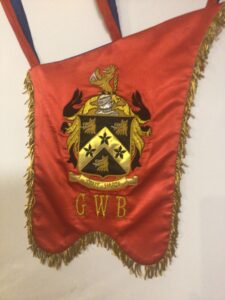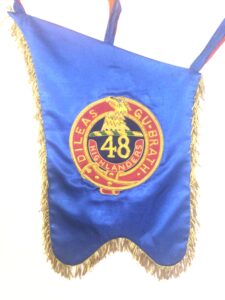Heraldry: Motto: Tout Hardi Translation: (French) Quite Bold Culture: English (Northumberland pre 1066) Reverse: An escutcheon sable with three estoiles gules sable on a chevron or between three wolves heads argent erased. or as many cinquefoils of the field. Above the shield surmounted by a closed helm upon which a rampant a demi Norse wolf or holding a tasseled spear head argent with its point directing upward, all in natural colour, on a field of gules. Below the initials G W B Obverse: 48th Highlanders, Buckle Badge, proper, on a field of azure
Service: Honourary Colonel 2007 – 2010; Honourary Lieutenant Colonel 2002 – 2007; 48th Highlanders 1964 – 1972 – Major
Also in recognition and honour of Major George William Beal, MC, 1st Battalion, 48th Highlanders of Canada, 1939 – 1945
In the 48th Highlanders of Canada it is the custom that all Field Officers (Company Commander, usually a Major) or higher have a Pipe Banner that is carried by their Piper on parade. It is tied by ribbons to the base drone of a set of bagpipes. On the obverse side the Regimental Badge is displayed, normally on a field of Royal Blue (Lt. Col. Duncan elected to use Davidson tartan and khaki to indicate his Regiment during war). On the reverse the personal arms of the Officer is displayed. When not on parade Pipe Banners are hung in the Officers’ Mess.
“The Beal coat of arms herby illustrated is officially documented in Burke’s General Armory.
The original description of the arms (shield) is as follows: “SA. A chev. Betw. Three wolves heads erased, or as many cinquefoils of the field.”
When translated the blazon also describes the original colours of the Beal Arms as: “Black with a gold chevron on which are emblazoned three black wolves’ heads torn jaggedly from their bodies.”
Above the shield and helmet is the crest which is described as: “A rampant half wolf holding a tasseled spearhead, with its point directing upward; all in natural colour.”


